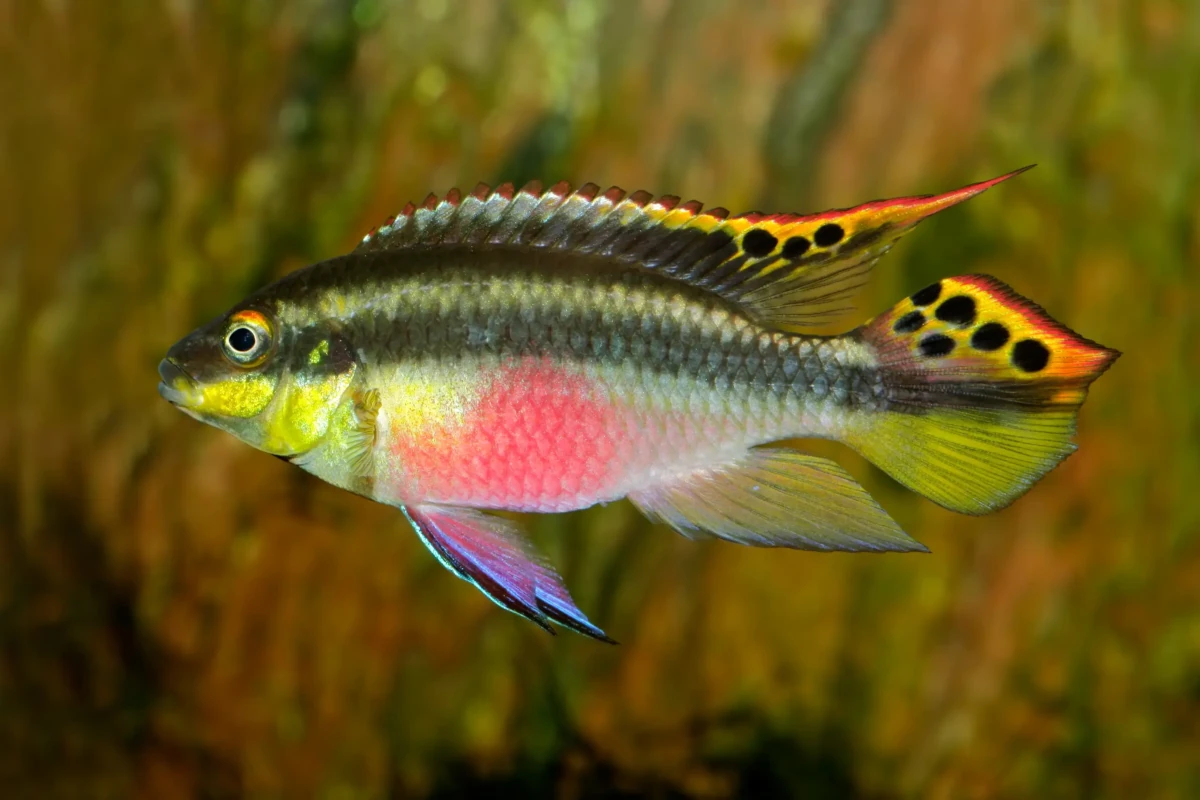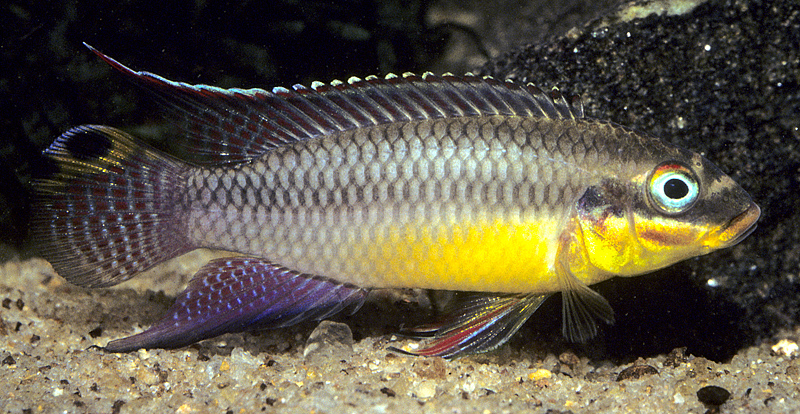Kribensis Cichlid
Renowned for their colorful aesthetics, Kribensis Cichlids, Pelvicachromis kribensis, are highly engaging aquatic residents that add great personality to an aquarium. Originating from a range of freshwater habitats in Western Africa and the coastal areas of Cameroon, Kribensis’ display a unique ability to flourish in varying aquatic conditions.
- Experience Level: Intermediate
- Hardiness: Moderate
- Minimum Tank Size: 75 gal (285 L)
- Maximum Size: 4 inches (10 cm)
- Temperament: Peaceful
- Temperature: 73 – 78° F (22.7 – 25.5° C)
- pH Range: 6.5 – 7.0
- Water Hardness: 8 – 12 dGH
- Diet: Omnivore
Table of Contents
Introduction
Size and Appearance
Care Guide
Tank Mates
Diet and Feeding
Breeding
The native lands of Kribensis include areas with soft, low PH black water to brackish, hard PH waters found in delta regions.
Due to their remarkable adaptability, you can raise Kribensis in both fresh and brackish waterbodies which make them resilient beings.
Size and Appearance
Kribensis stand out due to their radiant and captivating colors. They possess a svelte visage along with a circular-shaped head, while their coloring is profoundly vibrant. Typically, their base hue is either white or gray, complemented strikingly by the dark stripes running from the eyes to the tail.
The female Kribs, especially, display greater colorfulness, showing off a radiant red belly. They draw the males’ attention through their dazzling display of colors, especially during their breeding phase.
The two commonly found types of Kribensis are:
- Pelvicachromis pulcher
- Pelvicachromis taeniatus
Maintaining a variety of Kribensis intensifies the hues displayed in your aquarium, especially when you include males for the females to impress. The males assist in accentuating the colors of the females as they engage in breeding rituals.
Visually differentiating between male and female Kribensis involves a keen eye. The males are generally larger, equipped with pointed tails and dorsal fins, and show off an eyespot or ocelli on the caudal and dorsal fins. On the contrary, the females are slightly smaller, exhibit greater color variety, and possess rounded fins. Their size typically ranges between 3 to 4 inches, earning them the label of a dwarf cichlid.
While mild-mannered and largely non-aggressive, Kribensis can be territorial, especially when in pairs. Although it is possible to single-handedly manage a Kribensis, it’s suggested to keep them coupled for a balanced ecosystem. They do well in maintaining their territories when they are in pairs, and they also cohabit comfortably with several other fish species.
With an average lifespan of approximately five years, the length of their life largely depends on maintaining conducive environmental conditions.
Care Guide
- Minimum Tank Size: 75 gal (285 L)
- pH Range: 6.5 – 7.0
- Water Hardness: 8 – 12 dGH
- Temperature: 73 – 78° F (22.7 – 25.5° C)
- Lighting: Moderate, diffused lighting
- Substrate: Fine sand/gravel
- Brackish: Yes, if required as they can adapt
- Water Flow: Low to Moderate
- Tank Region: All areas
The initial, basic step to caring for Kribensis is to provide a comfortable and favorable environment. Sudden changes or fluctuation in water conditions can stress the fish and increase susceptibility to diseases. To offer the best care possible and prolong their lifespan, it’s necessary to maintain the best tank conditions.
Kribensis are susceptible to drastic changes in the pH and temperature levels, emphasizing the need to maintain the recommended nitrate level below 20ppm to prevent potential immune system compromise and oxidative stress.
When keeping Kribensis, providing ample shelter areas like hardscape or cichlid caves is recommended. Most pet supply stores offer purchasable options or alternately, you could employ a terra cotta flower pot as your DIY cichlid cave.
Tank Mates
Being generally peaceful by nature, Kribs get along well with an array of tank mates outside of their breeding cycle. However, larger, aggressive species, especially other large cichlids, are not suitable to house with Kribs. Other fish species that Kribs do not fare well with include invertebrates and bottom dwellers.
Feeding Guide
- Diet: Omnivore
- Frequency: Several small feedings per day
- Pellet Foods: Yes
- Flake Foods: Yes
- Live Foods: Yes
- Meat Foods: Yes
- Vegetable Foods: Yes
Kribensis, both adult or fry, ought to be nourished well to grow. However, in the first three days following hatching, the fry can survive by absorbing their egg sack. Once this phase is complete, they can be fed baby brine shrimp for the first two weeks, shifting to flake food gradually.
Overfeeding should be avoided to prevent bloating. A safe practice is to provide just enough food that can be consumed within 30 seconds, feeding them two to three times a day. For feeding baby Kribensis, a pipette or a turkey baster can be used in the initial weeks.
Kribensis are omnivores and the adult Kribs have a wide diet palette that includes:
- Flakes
- Micropellets
- Frozen foods
- Mosquito larvae
- Algae wafers
- Blood larvae
- Daphnia etc
Supplementary fresh greens such as dandelion, flaked pea, and blanched spinach can also be used to balance out the diet of Kribensis.
Breeding
When it comes to breeding, Kribensis become highly territorial, necessitating an aquarium of at least 3ft in length if they share the environment with other species. They tend to select secluded, dark corners for breeding, and during non-breeding periods, they are congenial and get along well with various other fish species.
When ready to breed, the female Kribensis utilizes her radiant colors to draw in a male. The brighter colors act as a lure to captivate the male’s attention, following which a ritualistic dance ensues to signal readiness for mating. The female then lays her eggs securely by the pond’s edge, with a female being capable of laying up to 300 eggs. The eggs take about 2-3 days to hatch while it takes an additional four days for the newborns to swim freely.
Monogamy is a trait common to Kribensis, as once they breed, they create a lifelong bond. During the time their eggs hatch, the male Kribensis becomes guardian of the breeding ground. While they are protective parents, their focus shifts to the next phase of breeding, during which they are prone to consuming their own fry. It is also imperative to note that Kribensis breed every 4-6 weeks unless physically separated.
Breeding Kribensis can be achieved in two ways. One way is via a dedicated tank for breeding, which requires a heater and sponge filters. Alternately, if a community tank is used for breeding Kribensis, a separate fry tank can be established to move the Kribensis for breeding and hatching.
Setting up a breeding tank for Kribensis involves careful consideration of factors such as:
- Tank Size – The ideal tank size is about 3-4 Ft long.
- Substrate – The aquarium should have a dark-hued substrate, ideally small gravel or sand to encourage spawning.
- Water Capacity – A dedicated breeding tank should ideally hold around 20-40 gallons of water.
- Water Hardness – The water hardness in the tank should be around 5 to 20 dGH.
- Temperature – A heater is needed to maintain the temperature around 77-79 degrees Fahrenheit to stimulate spawning.
- pH – To prevent developing primarily female fry, the pH level should be maintained at 7.0.
The female Krib often eats the unhatched eggs, offering protection to the hatched fry from getting the fundi disease. At about a month after hatching, the parent Kribs and fry should be provided with food, and the parents should be removed from the tank to protect the fry from potential risk.



